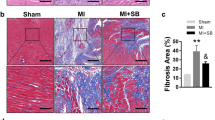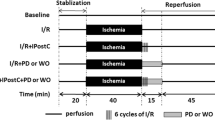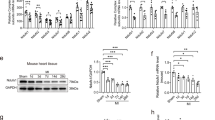Abstract
Gene-targeted therapy with the inotropic Ca2 + -sensor protein S100A1 rescues contractile function in post-ischemic heart failure and is being developed towards clinical trials. Its proven beneficial effect on cardiac metabolism and mitochondrial function suggests a cardioprotective effect of S100A1 in myocardial ischemia-reperfusion injury (IRI). Fivefold cardiomyocyte-specific S100A1 overexpressing, isolated rat hearts perfused in working mode were subjected to 28 min ischemia (37 °C) followed by 60 min reperfusion. S100A1 overexpressing hearts showed superior hemodynamic recover: Left ventricular pressure recovered to 57 ± 7.3% of baseline compared to 51 ± 4.6% in control (p = 0.025), this effect mirrored in LV work and dP/dt(max). Troponin T and lactate dehydrogenase was decreased in the S100A1 group, as well as FoxO pro-apoptotic transcription factor, indicating less tissue necrosis, whereas phosphocreatine content was higher after reperfusion. This is the first report of a cardioprotective effect of S100A1 overexpression in a global IRI model.







Similar content being viewed by others
References
Murphy, E., & Steenbergen, C. (2008). Mechanisms underlying acute protection from cardiac ischemia-reperfusion injury. Physiological Reviews, 88(2), 581–609. https://doi.org/10.1152/physrev.00024.2007.
Yellon, D. M., & Hausenloy, D. J. (2005). Realizing the clinical potential of ischemic preconditioning and postconditioning. Nature Clinical Practice. Cardiovascular Medicine, 2(11), 568–575. https://doi.org/10.1038/ncpcardio0346.
Hausenloy, D. J., Bøtker, H. E., Condorelli, G., Ferdinandy, P., Garcia-dorado, D., Heusch, G., … Ovize, M. (2013). Translating cardioprotection for patient benefit: position paper from the Working Group of Cellular Biology of the Heart of the European Society of Cardiology. Cardiovascular Research, 98, 7–27. https://doi.org/10.1093/cvr/cvt004.
Longnus, S. L., Mathys, V., Dornbierer, M., Dick, F., Carrel, T. P., & Tevaearai, H. T. (2014). Heart transplantation with donation after circulatory determination of death. Nature Reviews. Cardiology, 11(6), 354–363. https://doi.org/10.1038/nrcardio.2014.45.
Dyck, J. R. B., & Lopaschuk, G. D. (2002). Malonyl CoA control of fatty acid oxidation in the ischemic heart. Journal of Molecular and Cellular Cardiology, 34(9), 1099–1109. https://doi.org/10.1016/S0022-2828(02)92060-2.
Wang, Y., Gao, E., Tao, L., Lau, W. B., Yuan, Y., Goldstein, B. J., … Ma, X.-L. (2009). AMP-activated protein kinase deficiency enhances myocardial ischemia/reperfusion injury but has minimal effect on the antioxidant/antinitrative protection of adiponectin. Circulation, 119(6), 835–44. https://doi.org/10.1161/CIRCULATIONAHA.108.815043.
Lacerda, L., Somers, S., Opie, L. H., & Lecour, S. (2009). Ischaemic postconditioning protects against reperfusion injury via the SAFE pathway. Cardiovascular Research, 84(2), 201–208. https://doi.org/10.1093/cvr/cvp274.
Lecour, S. (2009). Activation of the protective Survivor Activating Factor Enhancement (SAFE) pathway against reperfusion injury: does it go beyond the RISK pathway? Journal of Molecular and Cellular Cardiology, 47(1), 32–40. https://doi.org/10.1016/j.yjmcc.2009.03.019.
Sengupta, A., Molkentin, J. D., & Yutzey, K. E. (2009). FoxO transcription factors promote autophagy in cardiomyocytes. Journal of Biological Chemistry, 284(41), 28319–28331. https://doi.org/10.1074/jbc.M109.024406.
Puthanveetil, P., Wan, A., & Rodrigues, B. (2013). FoxO1 is crucial for sustaining cardiomyocyte metabolism and cell survival. Cardiovascular Research, 97(3), 393–403. https://doi.org/10.1093/cvr/cvs426.
Abraham, W. T., Adams, K. F., & Fonarow, C. G. (2005). In-hospital mortality in patients with acute decompensated heart failure requiring intravenous vasoactive medications. An analysis from the Acute Decompensated Heart Failure National Registry (ADHERE). ACC Current Journal Review, 14(10). https://doi.org/10.1016/j.accreview.2005.09.046.
Packer, M., Carver, J. R., Rodeheffer, R. J., Ivanhoe, R. J., DiBianco, R., Zeldis, S. M., … et al. (1991). Effect of oral milrinone on mortality in severe chronic heart failure. The PROMISE Study Research Group. N Engl J Med., 325(21), 1468–75.
Remppis, A., Greten, T., Schäfer, B. W., Hunziker, P., Erne, P., Katus, H. A., & Heizmann, C. W. (1996). Altered expression of the Ca2+-binding protein S100A1 in human cardiomyopathy. Biochimica et Biophysica Acta - Molecular Cell Research, 1313(3), 253–257. https://doi.org/10.1016/0167-4889(96)00097-3.
Rohde, D., Schön, C., Boerries, M., Didrihsone, I., Ritterhoff, J., Kubatzky, K. F., et al. (2014). S100A1 is released from ischemic cardiomyocytes and signals myocardial damage via Toll-like receptor 4. EMBO Molecular Medicine, 6(6), 778–794. https://doi.org/10.15252/emmm.201303498.
Most, P., Remppis, A., Pleger, S. T., Katus, H. a., & Koch, W. J. (2007). S100A1: a novel inotropic regulator of cardiac performance. Transition from molecular physiology to pathophysiological relevance. American Journal of Physiology. Regulatory, Integrative and Comparative Physiology, 293, R568–R577. https://doi.org/10.1152/ajpregu.00075.2007.
Most, P., Pleger, S. T., Völkers, M., Heidt, B., Boerries, M., Weichenhan, D., … Koch, W. J. (2004). Cardiac adenoviral S100A1 gene delivery rescues failing myocardium. Journal of Clinical Investigation, 114(11), 1550–1563. https://doi.org/10.1172/JCI200421454.
Pleger, S. T., Shan, C., Ksienzyk, J., Bekeredjian, R., Boekstegers, P., Hinkel, R., … Most, P. (2011). Cardiac AAV9-S100A1 gene therapy rescues post-ischemic heart failure in a preclinical large animal model. Science translational medicine, 3(92), 92ra64. https://doi.org/10.1126/scitranslmed.3002097.
Pleger, S. T., Brinks, H., Ritterhoff, J., Raake, P., Koch, W. J., Katus, H. A., & Most, P. (2013). Heart failure gene therapy: the path to clinical practice. Circulation Research, 113(6), 792–809. https://doi.org/10.1161/CIRCRESAHA.113.300269.
Piper, H. M., Kasseckert, S., & Abdallah, Y. (2006). The sarcoplasmic reticulum as the primary target of reperfusion protection. Cardiovascular Research, 70(2), 170–173. https://doi.org/10.1016/j.cardiores.2006.03.010.
Boerries, M., Most, P., Gledhill, J. R., Walker, J. E., Katus, H. A, Koch, W. J., … Schoenenberger, C.-A. (2007). Ca2+-dependent interaction of S100A1 with F1-ATPase leads to an increased ATP content in cardiomyocytes. Molecular and cellular biology, 27(12), 4365–4373. https://doi.org/10.1128/MCB.02045-06.
Dornbierer, M., Stadelmann, M., Sourdon, J., Gahl, B., Cook, S., Carrel, T. P., … Longnus, S. L. (2012). Early reperfusion hemodynamics predict recovery in rat hearts: a potential approach towards evaluating cardiac grafts from non-heart-beating donors. PLoS ONE, 7(8). https://doi.org/10.1371/journal.pone.0043642.
Farine, E., Niederberger, P., Wyss, R. K., Méndez-Carmona, N., Gahl, B., Fiedler, G. M., … Longnus, S. L. (2016). Controlled reperfusion strategies improve cardiac hemodynamic recovery after warm global ischemia in an isolated, working rat heart model of Donation after Circulatory Death (DCD). Frontiers in Physiology, 7 (November), 1–11. https://doi.org/10.3389/fphys.2016.00543.
Stadelmann, M., Dornbierer, M., Clément, D., Gahl, B., Dick, F., Carrel, T. P., … Longnus, S. (2013). Mild hypothermia during global cardiac ischemia opens a window of opportunity to develop heart donation after cardiac death. Transplant International, 26(3), 339–348. https://doi.org/10.1111/tri.12022.
Weber, C., Neacsu, I., Krautz, B., Schlegel, P., Sauer, S., Raake, P., … Pleger, S. T. (2014). Therapeutic safety of high myocardial expression levels of the molecular inotrope S100A1 in a preclinical heart failure model. Gene therapy, 21(2), 131–8. https://doi.org/10.1038/gt.2013.63.
Remppis, A., Most, P., Loffler, E., Ehlermann, P., Bernotat, J., Pleger, S., … Katus, H. A. (2002). The small EF-hand Ca2+ binding protein S100A1 increases contractility and Ca2+ cycling in rat cardiac myocytes. Basic Res Cardiol, 97 Suppl 1, I56–62. Retrieved from http://www.ncbi.nlm.nih.gov/entrez/query.fcgi?cmd=Retrieve&db=PubMed&dopt=Citation&list_uids=12479236.
Kim, M., & Tian, R. (2011). Targeting AMPK for cardiac protection: opportunities and challenges. Journal of Molecular and Cellular Cardiology, 51(4), 548–553. https://doi.org/10.1016/j.yjmcc.2010.12.004.
Remppis, A., Scheffold, T., Greten, J., Haass, M., Greten, T., Kübler, W., & Katus, H. A. (1995). Intracellular compartmentation of troponin T: release kinetics after global ischemia and calcium paradox in the isolated perfused rat heart. Journal of Molecular and Cellular Cardiology, 27(2), 793–803. https://doi.org/10.1016/0022-2828(95)90086-1.
Kandula, V., Kosuru, R., Li, H., Yan, D., Zhu, Q., Lian, Q., … Irwin, M. G. (2016). Forkhead box transcription factor 1: role in the pathogenesis of diabetic cardiomyopathy. Cardiovascular diabetology, 15, 44. https://doi.org/10.1186/s12933-016-0361-1.
Brinks, H., Rohde, D., Voelkler, M., Qiu, G., Pleger, S.T., Herzog, N., … Most, P. (2011). S100A1 genetically targeted therapy reverses dysfunction of human failing cardiomyocytes. Journal of the American College of Cardiology, 58(9):966–73.
Most, P., Bernotat, J., Ehlermann, P., Pleger, S.T., Reppel, M., Börries, … Remppis, A. (2001) S100A1: a regulator of myocardial contractility. Proc Natl Acad Sci USA, 98(24):13889–94.
Most, P., Seifert, H., Gao, E., Funakoshi, H., Voelkers, M., Heierhorst, J., … Koch, W.J. (2006) Cardiac S100A1 protein levels determine contractile performance and propensity toward heart failure after myocardial infarction. Circulation, 114(12):1258–68.
Funding
This work was supported by a Project Grant from the Swiss National Science Foundation (310030_149730/1 to S.L.) and a Research Grant from the Ruth & Arthur Scherbarth Foundation (to H.M. and S.L.), M.B. and P.M. receive funding via the German Center for Cardiovascular Research (DZHK).
Author information
Authors and Affiliations
Corresponding author
Ethics declarations
Conflict of Interest
The authors declare that they have no conflict of interest.
Additional information
Associate Editor Saptarsi Haldar oversaw the review of this article
Rights and permissions
About this article
Cite this article
Jungi, S., Fu, X., Segiser, A. et al. Enhanced Cardiac S100A1 Expression Improves Recovery from Global Ischemia-Reperfusion Injury. J. of Cardiovasc. Trans. Res. 11, 236–245 (2018). https://doi.org/10.1007/s12265-018-9788-y
Received:
Accepted:
Published:
Issue Date:
DOI: https://doi.org/10.1007/s12265-018-9788-y




